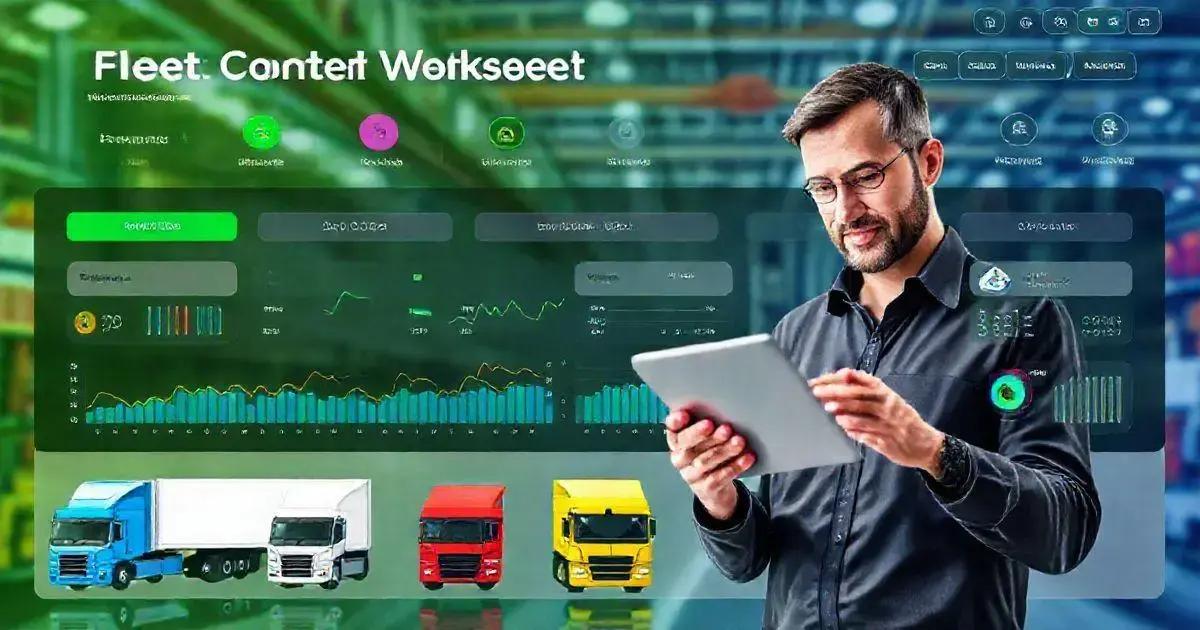Maximize Efficiency with Fleet Control Worksheet 7.0 Leave a comment
The Fleet Control Worksheet 7.0 is a vital tool for fleet managers, offering features like maintenance management, travel expense tracking, tire management, and centralized document organization to enhance vehicle reliability, reduce costs, and improve overall fleet performance.
The Fleet Control Worksheet is an essential tool for any business looking to optimize their fleet management. Version 7.0 introduces a host of features that can revolutionize how you track vehicle performance, costs, and maintenance schedules.
This comprehensive worksheet is designed with ease of use in mind, allowing managers to manage their fleet efficiently and effectively.
Initial Dashboards Overview
The Initial Dashboards of the Fleet Control Worksheet 7.0 provide a powerful overview of fleet performance metrics at a glance. These dashboards are designed to give fleet managers essential insights into various factors affecting their operations, ensuring they can make data-driven decisions swiftly.
Key Metrics Displayed:
Key Metrics Displayed:
- KM by Driver: This metric tracks the total kilometers driven by each driver, allowing managers to assess driving performance and monitor any excessive usage.
- KM per Vehicle: Similar to the driver metric, this provides insights into how many kilometers each specific vehicle has covered, helping identify underutilized vehicles.
- KM per Liter: This performance indicator measures fuel efficiency by showing how many kilometers are achieved per liter of fuel, highlighting any potential areas for improvement in fuel management.
- KM per Trip: Understanding the distance covered per trip helps in evaluating the efficiency of routes and planning better logistics.
- Average Consumption per Vehicle: This data point gives the average fuel consumption per vehicle, useful for identifying vehicles that may require maintenance or adjustment.
- Average Consumption per Driver: It helps in evaluating driver efficiency by indicating how much fuel each driver consumes on average, which can lead to targeted training if necessary.
- Total General, Preventive and Corrective Maintenance Costs: Keeping track of overall maintenance costs provides clarity on spending and can help in budgeting for future expenses.
- Maintenance Cost Average: This metric allows managers to see the average maintenance costs over a specified period, facilitating better financial forecasting.
- Total cost of Mechanical and Electrical Maintenance: Understanding the total costs spent on mechanical and electrical maintenance helps in identifying whether investments are yielding the expected returns.
- Total Tire Maintenance Cost: This metric indicates how much is spent on tire maintenance, essential for managing one of the most critical components of fleet safety.
- Total Lubricant Cost: Keeping track of lubricant costs helps in making informed purchasing decisions and ensuring optimal vehicle performance.
- Average cost of Mechanical and Electrical Maintenance: This averages out the costs involved in mechanical and electrical repairs, assisting in overall budget planning.
- Average Tire Maintenance Cost: This figure aids managers in assessing how efficiently they are managing tire resources.
- Average cost with Lubricants: Evaluating lubricant costs over time can help in negotiating better prices with suppliers.
- Vehicles in Transit: This live metric shows how many vehicles are currently in transit, offering real-time insight into fleet operations.
- Tires in Transit: Similar to vehicles, this tracks how many tires are currently on the road, important for logistics and inventory management.
- Delayed Vehicle Documents: Managers can easily see which vehicles have pending documentation, essential for compliance and legal issues.
- Delayed Driver Documents: Keeping track of driver documentation ensures that all personnel are adequately certified and that the fleet is compliant with regulations.
- Delayed Preventive Maintenance: This alerts managers to any overdue maintenance, crucial for ensuring vehicle reliability and safety.
- Total Cost Versus Shipping: This comparison helps in understanding the relationship between operational costs and revenue generated from shipping.
- Fuel, Maintenance, and Other Costs: An aggregate of all costs involved, offering a comprehensive view of fleet expenditure, aiding in financial management.
By leveraging these metrics, fleet managers can swiftly identify areas for improvement, optimize fleet operations, and ensure their vehicles and drivers are performing at their best.

Key Features of Fleet Control Worksheet
The Fleet Control Worksheet 7.0 is packed with features designed to enhance fleet management efficiency and effectiveness. Here are some of the key features that set this worksheet apart:
1. User-Friendly Interface:
The worksheet is designed with a clean, intuitive interface that makes navigation simple for all users, regardless of their technical expertise. This allows for quick access to all essential functions without confusion.
2. Comprehensive Dashboard:
A detailed dashboard provides a visual overview of your fleet’s performance metrics, making it easy to identify trends and make informed decisions. The dashboard includes dynamic charts and graphs for better data representation.
3. Detailed Maintenance Tracking:
Keep track of all maintenance activities with automated reminders for preventive maintenance and repairs. This ensures that vehicles remain in optimal condition, minimizing breakdowns and downtime.
4. Fuel Management:
The worksheet allows you to log and analyze fuel consumption, helping to identify inefficiencies and optimize fuel expenses. By keeping detailed records, fleet managers can make strategic decisions regarding fuel purchases.
5. Cost Comparison:
With built-in functionalities for comparing various costs—such as maintenance, fuel, and operational expenses—users can easily assess the overall financial health of their fleet.
6. Real-Time Updates:
Data is easily updated in real-time, allowing for immediate insights into fleet operations. This feature is crucial for making timely decisions, especially during peak operational periods.
7. Customizable Reports:
Generate customizable reports based on specific parameters, such as vehicle type, driver performance, and maintenance history. These reports can be used to present data to stakeholders or for internal analysis.
8. Document Management:
Keep all essential documents organized within the worksheet—such as insurance papers, registration, and maintenance records—ensuring that everything is easily accessible and in one place.
9. Driver Management:
Monitor driver performance by keeping track of their driving habits, mileage, and compliance with regulations. This feature enables fleet managers to provide targeted training to improve driver safety and efficiency.
10. Integration Capabilities:
Designed to work seamlessly with existing systems, the Fleet Control Worksheet can be integrated with other fleet management tools and software, enhancing data flow and operational efficiency.
These key features work together to create a comprehensive fleet management solution that increases operational efficiency, reduces costs, and enhances decision-making, ultimately leading to a more effective fleet operation.
Maintenance Management
Maintenance Management is a critical aspect of fleet management that ensures vehicles remain in peak operating condition, thereby reducing downtime and maximizing productivity. The Fleet Control Worksheet 7.0 offers robust tools and features that streamline maintenance management processes.
1. Comprehensive Maintenance Log:
The worksheet includes a detailed maintenance log that tracks all maintenance activities performed on each vehicle. This log captures essential data such as the date of service, type of maintenance (preventive or corrective), mileage at service, and costs involved. This thorough documentation not only helps in maintaining a record of service history but also assists in budgeting for future maintenance costs.
2. Automated Reminders:
One of the standout features is the automated reminder system that alerts fleet managers when preventive maintenance is due. This proactive approach helps ensure that maintenance tasks are completed on schedule, thus preventing potential breakdowns and extending the lifespan of the vehicles.
3. Maintenance Cost Analysis:
The Fleet Control Worksheet allows for comprehensive analysis of maintenance costs, helping managers identify trends in spending. Users can compare costs across different vehicles and maintenance types, which aids in making informed decisions about resource allocation and identifying areas for cost savings.
4. Preventive vs. Corrective Maintenance Tracking:
The worksheet distinguishes between preventive and corrective maintenance, enabling fleet managers to assess their maintenance strategies effectively. By analyzing the ratio of preventive to corrective maintenance, managers can adapt their approaches to minimize unplanned repairs and optimize scheduled services.
5. Maintenance Performance Metrics:
Fleet managers can evaluate the effectiveness of their maintenance programs by tracking key performance metrics, such as average downtime per vehicle and average cost per service. This data provides insights into the efficiency of maintenance operations and helps drive improvements.
6. Integration with Vehicle Performance Data:
The maintenance management system seamlessly integrates with vehicle performance data, allowing managers to correlate maintenance activities with vehicle performance metrics. This integration helps identify patterns between maintenance tasks and vehicle reliability, leading to more strategic decision-making.
7. Vendor and Service Provider Management:
Keep track of all vendors and service providers used for vehicle maintenance. The worksheet allows for logging contact information, service histories, and cost comparisons, ensuring fleet managers can quickly find the best service options when needed.
8. Documentation and Compliance:
Maintaining proper documentation is crucial for compliance with regulations. The Fleet Control Worksheet provides features for logging important documents related to maintenance, such as service orders and warranty details, ensuring that all necessary paperwork is readily accessible.
By effectively managing maintenance within the Fleet Control Worksheet 7.0, fleet managers can not only enhance vehicle reliability but also contribute to overall operational efficiency and cost-effectiveness in their fleet operations.

Travel Control and Cargo Management
Travel Control and Cargo Management are essential components of effective fleet operations, ensuring that vehicles are efficiently utilized for transporting goods while maintaining accurate records. The Fleet Control Worksheet 7.0 provides comprehensive features to manage travel and cargo seamlessly.
1. Trip Planning Tools:
Fleet managers can utilize built-in trip planning tools to schedule routes for each vehicle, considering factors such as distance, estimated travel time, and cargo requirements. This feature helps optimize the fleet’s operational efficiency by minimizing travel costs and maximizing delivery schedules.
2. Cargo Tracking:
The worksheet allows for detailed cargo tracking, providing an overview of what is being transported, including quantities, types, and destinations. This level of detail helps ensure accuracy in deliveries and enhances customer satisfaction by providing reliable service.
3. Vehicle Assignment:
Managers can easily assign vehicles to specific trips based on their availability and suitability for the cargo type. This feature optimizes resource allocation, ensuring the right vehicles are used for the right cargo, ultimately reducing wear and tear and maintenance needs.
4. Travel Expense Management:
The Fleet Control Worksheet enables tracking of all travel-related expenses, including fuel, tolls, and maintenance costs incurred during trips. By logging these expenses, fleet managers can better understand the true cost of operations and identify potential areas for savings.
5. Real-Time Updates:
Managers can input real-time data about ongoing trips, including delays, detours, or any changes in cargo status. This feature allows for immediate adjustments to be made, ensuring that operations remain flexible and responsive to unexpected circumstances.
6. Historical Travel Data Analysis:
By logging and analyzing historical travel data, fleet managers can identify trends in travel patterns, vehicle performance, and cargo delivery times. This analysis aids in making informed decisions regarding route optimization and resource allocation for future trips.
7. Compliance and Documentation:
The worksheet helps maintain compliance with regulations related to cargo transport by ensuring that all necessary documentation is organized and easily accessible. This includes load manifests, delivery confirmations, and any required permits, which can be crucial during inspections.
8. Performance Metrics:
Travel performance metrics, such as on-time delivery rates, average trip duration, and cargo damage reports, can be tracked and analyzed. These metrics provide insights into the effectiveness of travel operations and can highlight areas for improvement.
By effectively managing travel control and cargo within the Fleet Control Worksheet 7.0, fleet managers can enhance operational efficiency, improve resource utilization, and ensure timely deliveries, ultimately leading to higher customer satisfaction and reduced operational costs.
Tire Control Strategies
Tire Control Strategies are crucial for maintaining the safety and efficiency of a fleet’s operations. Proper management of tire resources ensures that vehicles are running optimally while minimizing costs associated with tire purchases and maintenance. The Fleet Control Worksheet 7.0 incorporates effective strategies for comprehensive tire management.
1. Tire Inventory Management:
The worksheet allows fleet managers to maintain a detailed inventory of all tires in use, including their condition, specifications, and locations. This systematic tracking helps prevent tire shortages and ensures that managers can quickly replace tires when necessary.
2. Tire Change Schedule:
A built-in tire change schedule provides guidelines for when tires should be rotated or replaced based on mileage and wear patterns. This proactive approach extends the lifespan of tires and enhances vehicle performance.
3. Monitoring Tire Performance:
Regularly monitoring tire performance is essential for identifying trends such as uneven wear or frequent punctures. The worksheet enables users to log performance data, which can be analyzed to make informed decisions about tire maintenance and replacement strategies.
4. Automated Alerts:
The Fleet Control Worksheet can send automated alerts for upcoming tire maintenance tasks, such as rotations or inspections. These reminders help ensure that tire care is not overlooked, keeping safety as a top priority.
5. Cost Analysis:
By tracking all costs related to tire purchases, maintenance, and replacements, fleet managers can conduct thorough cost analyses. Understanding these expenses helps in budgeting and finding ways to reduce tire-related costs without sacrificing quality.
6. Tire Allocation Strategies:
The worksheet assists in developing tire allocation strategies based on the specific needs of each vehicle and its usage patterns. For instance, heavier vehicles may require more robust tires, while lighter vehicles might use more economical options.
7. Tire Supplier Management:
Manage relationships with tire suppliers directly within the worksheet. Keeping track of supplier contact information, pricing agreements, and service histories ensures that managers can negotiate better deals and maintain reliable sources for tire procurement.
8. Assessment of Tire Lifespan:
Evaluating the lifespan of tires based on historical data allows fleet managers to make informed choices regarding replacements. This assessment includes factors such as age, usage, and maintenance records to maximize tire efficiency.
9. Environmental Considerations:
Implementing tire recycling and proper disposal practices is part of a comprehensive tire control strategy. The worksheet provides insights into environmentally friendly options and helps ensure compliance with local regulations regarding tire disposal.
By employing these tire control strategies within the Fleet Control Worksheet 7.0, fleet managers can enhance safety, improve operational efficiency, and ultimately reduce costs associated with tire maintenance and replacement.

Document Management for Fleet Vehicles
Document Management for Fleet Vehicles is a vital component of effective fleet operations. Proper management of vehicle-related documents ensures compliance, enhances operational efficiency, and facilitates easier access to important information. The Fleet Control Worksheet 7.0 provides robust features for managing all essential documentation related to fleet vehicles.
1. Centralized Document Repository:
The worksheet allows fleet managers to maintain a centralized repository for all vehicle-related documents. This includes registration papers, insurance documents, maintenance records, and inspection certifications. Having all documents in one place simplifies retrieval and organization.
2. Document Expiration Tracking:
Automated tracking of document expiration dates ensures that fleet managers are promptly alerted when documents such as insurance or registration are due for renewal. This proactive feature helps maintain compliance and avoid potential penalties.
3. Easy Document Upload:
Users can easily upload scanned copies of important documents directly into the worksheet. This feature ensures that all records are digitized and accessible, reducing the reliance on physical paperwork.
4. Compliance Management:
Keeping track of compliance documents is essential for fleet operations, especially in regulated industries. The worksheet facilitates logging and monitoring compliance-related documents, ensuring that all requirements are met.
5. Quick Access to Key Information:
Fleet managers can quickly access crucial information such as vehicle specifications, maintenance history, and service contracts. This quick access aids in making informed decisions during fleet operations and maintenance planning.
6. Document Sharing and Collaboration:
The worksheet supports easy sharing of documents among team members. This collaboration feature ensures that everyone involved in fleet management has access to the necessary information to perform their duties effectively.
7. Audit Trail:
A built-in audit trail feature records all changes made to documents, including who accessed or modified them and when. This accountability is vital for compliance and internal audits, ensuring transparency in document management processes.
8. Reporting Capabilities:
Generate reports based on document management activities, such as outstanding renewals or missing documents. These reports provide a clear overview of the fleet’s compliance status and help identify areas needing attention.
9. Secure Document Storage:
Ensure that sensitive documents are stored securely within the worksheet. Access controls can be implemented to restrict who can view or modify specific documents, safeguarding confidential information.
10. Integration with Other Systems:
The Fleet Control Worksheet can integrate with other fleet management systems, allowing for seamless data flow between platforms. This integration enhances the efficiency of document management and ensures that all relevant information is up-to-date.
By implementing effective document management strategies within the Fleet Control Worksheet 7.0, fleet managers can ensure that all vehicle-related documentation is organized, accessible, and compliant with regulatory requirements, ultimately leading to more efficient fleet operations.
Conclusion
In summary, the Fleet Control Worksheet 7.0 is an invaluable tool for fleet managers striving to optimize their operations. With its comprehensive features encompassing maintenance management, travel control, tire strategies, and document management, this worksheet empowers users to make informed decisions that enhance efficiency and reduce costs.
By utilizing the powerful dashboards and detailed tracking capabilities, fleet managers can stay on top of vehicle performance, ensure timely maintenance, and effectively manage cargo and travel logistics. The automated reminders and document tracking ensure compliance while providing peace of mind.
Ultimately, adopting the Fleet Control Worksheet 7.0 allows organizations to streamline their fleet operations, promote safety, and improve overall profitability. As fleets continue to play a critical role in logistics and transportation, leveraging modern tools like this worksheet is essential for maintaining a competitive edge in the industry.
FAQ – Frequently Asked Questions about Fleet Control Worksheet 7.0
What is the Fleet Control Worksheet 7.0?
The Fleet Control Worksheet 7.0 is a comprehensive tool designed for fleet managers to optimize vehicle management, maintenance, travel control, and document management.
How can the worksheet help with maintenance management?
The worksheet provides features for tracking maintenance activities, setting automated reminders for preventive maintenance, and analyzing maintenance costs to enhance vehicle reliability.
Can I track cargo and travel expenses using this worksheet?
Yes, the worksheet includes functionalities for trip planning, cargo tracking, and managing all travel-related expenses, providing a complete overview of logistics operations.
Is the Fleet Control Worksheet easy to use?
Absolutely! The worksheet is designed with a user-friendly interface, making it accessible for users of all skill levels.
How does the tire control feature work?
The tire control feature allows for inventory management, monitoring tire performance, scheduling tire changes, and tracking related costs, ensuring optimal tire usage and safety.
Can I integrate the worksheet with other fleet management tools?
Yes, the Fleet Control Worksheet can be integrated with other systems, enhancing data flow and operational efficiency.

